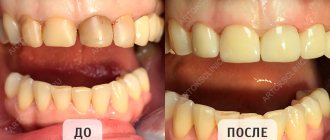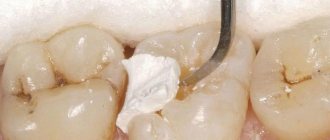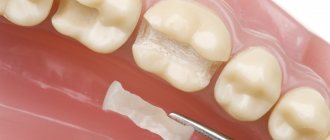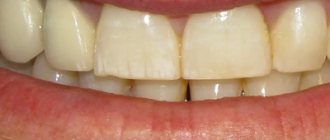5900
Everyone knows that the success of the treatment performed depends on the experience and qualifications of the dentist.
However, not everyone evaluates the quality and composition of the material used in the process of filling a tooth as a fundamental factor in the durability of the filling.
What is a cement filling, and how justified is such a choice? This will be discussed in this article.
General overview
Cement composite used in dentistry is made from a powder mixture and a liquid concentrated acid composition.
As a result of the combination of these elements, a mass is formed, characterized by a paste-like consistency, capable of hardening in a fairly short time.
Advantages of the material:
- lower cost of the composite compared to alternative solutions;
- when working with cement, the use of complex devices and tools is not required;
- the procedure for forming the mass and its installation is carried out quickly and does not require special training of the dentist.
Cement fillings are not without their disadvantages:
- the hardened composite is unable to maintain its original shape and volume over a long period of time;
- the time required for the mass to completely harden is an order of magnitude longer than that of many modern filling compounds;
- poor resistance to external negative mechanical influence - unable to withstand the pressure exerted on them, the composition cracks and gradually loses its structural integrity;
- does not guarantee recurrent manifestations in the form of the development of repeated caries;
- in the process of incorrectly installing a filling, there is a risk of puncturing a part of a healthy organ;
- cement belongs to the category of toxic elements, and is not always biocompatible with natural tissues.
Drugs used for intraligamentary anesthesia and manipulation techniques.
Read reviews about dental treatment under a microscope here.
At this address https://www.vash-dentist.ru/lechenie/zubyi/kofferdam-v-stomatologii.html the price of a rubber dam in dentistry is announced.
Plastic fillings
The appearance of plastic fillings in dentistry was a breakthrough of sorts. The vast majority of them are derivatives of acrylic acid. This is a material with high mechanical strength, which ensures the durability of fillings, the ability to choose their color and, after grinding and polishing, give them the appearance of healthy enamel.
The disadvantages of plastic are their fragility and porosity. Due to their porosity, such fillings often become the cause of secondary caries, because pathogenic microorganisms multiply well in the pores. All aesthetics also quickly fade away; the plastic becomes darker from nicotine and food coloring. In addition, acrylic plastics are toxic and negatively affect the pulp.
Epoxy two-component composites based on epoxy resins are much safer. Their toxicity is not as pronounced as that of acrylic-based polymers. Such fillings wear out even more slowly, but they are more fragile, so they do not restore the cutting edge of the tooth.
Varieties
Such composites contain:
- silicates – almost 45% consist of silicon, which gives the mass transparency and shine after it has completely hardened. It has a high coefficient of mechanical stability and good strength.
The main difference from other cements is the complete absence of the zinc element in them, which results in its disadvantage - low adhesion to enamel tissues.The process of complete crystallization is about 28 days, which is much slower than analog mixtures. It includes silicic acid, which releases toxins, so when installing such a filling, a gasket is required that does not allow direct contact of silicates with the pulp;
- phosphates – modified zinc-based cements. In terms of their basic physical and chemical characteristics, they are somewhat better than silicates.
At the same time, they are very inferior to them in terms of aesthetics, so they are practically not used for frontal filling. The consistency is more viscous.Such compositions are an ideal option for subsequent covering with decorative crowns. They finally harden just a few hours after the manipulation.
In demand in pediatric dentistry. For complete hardening, it is advisable to exclude direct contact of the composite with saliva;
- glass ionomers – belong to the modern and widely used cements by Russian doctors. They represent an almost ideal ratio of liquid and powder.
It is characterized by good transparency and resistance to the acidic environment contained in saliva, which increases the durability of the material.It does not irritate the natural tissues of the organ and adheres well to them. The material is safe for the pulp. Gives low shrinkage during operation.
Almost all of them, with the exception of the last material, are chemically active components and harden naturally.
Glass ionomer hardens only when interacting with an acidic environment or light wave flows.
What is dental filling?
Dental filling is a widespread dental procedure that consists of filling pathological cavities in tooth tissues with a special plastic and quickly hardening material.
Installing a filling allows you to isolate sensitive dental tissues from external influences, prevent the formation of entrance gates for infection, and restore the natural shape and chewing functions of damaged teeth.
Preparatory activities
Preliminary manipulations before installing a cement filling:
- a thorough inspection of the working surface for the presence of inflammatory formations, removal of plaque and rocky deposits so that their fragments do not fall into the tooth cavity and internal initiation does not occur;
- X-ray diagnostics - this is the only way to understand the true clinical picture and extent of the lesion;
- anesthesia and dissection of the damaged organ;
- preparation of the working area - it is expanded to the required size, given the necessary relief, sharp fragments and irregularities are ground off. All these measures will be the key to strong fixation of the mass;
- separation of the organ from neighboring units with a cotton swab or paper sponges - thus eliminating contact with salivary secretions, which negatively affects the quality and time of hardening of the cement mass;
- local-spectrum medications
- drying the treated part of the tooth with targeted air flows;
- if necessary, apply insulating material. To do this, using a cotton pad, dentin obtained by mixing distilled water and dentin powder in a ratio of 1:2 is evenly distributed along the bottom of the cavity. Then the remaining composition is removed with a special spatula;
If there is no need for a gasket, it is enough to simply treat the inner surface after its preparation with a special conditioner for 10 - 15 seconds. Then rinse well with water and dry thoroughly with air.
The main thing is to prevent the surface from becoming too dry, otherwise the adhesion strength of the cement to the inner surface of the hole will be worse.
What does aching teeth mean and the causes of the unpleasant phenomenon.
In this publication, we suggest that you familiarize yourself with the international classification of caries according to ICD 10.
Follow the link https://www.vash-dentist.ru/lechenie/zubyi/effektiven-li-analgin-ot-boli.html if you are interested in whether Analgin helps with toothache.
What is a tooth filling?
Every person has visited the dentist at least once to have a tooth filled. But not everyone knows how this process should proceed correctly, what material should be used. Filling is considered a labor-intensive process that requires certain skills and professionalism from the doctor. Only then will the tooth not fall out and break quickly.
Today there are many different materials that dentists work with. Fillings are divided into two types - permanent and temporary. In addition, they can be made from various cements, ceramics, metal or plastic. Each of the listed materials is suitable for a specific tooth.
Staging process
The procedure for installing a filling is perhaps the most common dental procedure. Due to their low cost, two out of three patients in domestic clinics choose such materials.
The specialist’s step-by-step algorithm is as follows:
- Preparation of the cement composite is done on site, immediately before installing the filling. Using a special spatula, the doctor mixes the powder with liquid with constant wave-like movements and brings the composition to a uniform paste-like consistency.
- Composite application – is performed one-time, therefore it requires precision movements and a certain dexterity.
In a fairly short period of time, it is necessary not only to restore the coronal area of the destroyed organ, but also to make it an exact copy of the lost tooth.Unlike cement, glass ionomers are applied in stages, in several layers. Each of them undergoes a polymerization procedure with a special lamp.
Each layer takes no more than 40 seconds. During this time, the layer has time to crystallize.
- Checking the correct placement - the patient is given a piece of copy paper and asked to bite on it.
All inaccuracies and protruding fragments will appear on the carbon copy - the sheet in these places will become lighter, and the cement mass, on the contrary, will acquire a zonal coloring of the excess areas. They are removed with a drill using a fine-grained thin attachment. - Polishing, grinding - the finished filling is carefully ground on all sides, bringing it to an almost smooth state, and polished with pastes.
Upon completion of all work, the outer surface is covered with a protective varnish, which increases the service life of the material and prevents too active shrinkage and the manifestations of secondary caries.
The best dental filling – how to choose it?
There are certain requirements for this material:
- the chewing surface of the tooth that has been filled must be smooth, chew food normally, and have no bumps;
- completely protect the tooth and its cavity, there should be no air gaps;
- There should be no contact with adjacent teeth. In the case of a lateral filling, there must be point contact;
- good fillings do not extend beyond the tooth;
- After polishing, the tooth should be covered with a composite material.
To understand what is best, you should definitely consult a dentist. In our clinic “Family Dentistry Center” we treat all types of caries; we use only high-quality and proven material.
After the procedure
Experts do not identify any serious restrictions or recommendations in this regard. The only requirement is some dietary restrictions.
The first few hours after filling with cement composites, you should avoid eating or drinking drinks containing coloring pigments - they can change the color of the composition, especially when it comes to treating the frontal part of the jaw row.
For the same reason, it is advisable to exclude for the next few days:
- strong coffee and tea;
- vegetables that have the ability to color - tomatoes, beets, spinach.
Note. You can start eating only when the effect of painkillers has completely stopped.
Otherwise, there is a risk of inadvertently injuring the mucous membrane when chewing food fragments due to the low sensitivity of nerve endings in the area of dental work.
And, of course, doctors recommend coming to the procedure well-fed - this reduces the reproduction of salivary secretions , which makes the doctor’s work much easier. And on an empty stomach it is much more difficult to deal with stressful emotions.
Reviews about our dental therapists
Words cannot express my gratitude to Elena Nikolaevna Kiseleva.
This is the best doctor in the world. I got an appointment after many years of being ignored by the dentist’s office and with the bitter experience of treatment in another paid clinic, the mistakes of which had to be corrected in the first visits. Thank you for this... Read full review Roman Stanislavovich Sh
25.07.2020
I would like to thank the wonderful doctor Natalya Olegovna Elizarova for her high professionalism, sensitive and kind attitude, the doctor has golden hands! He is honestly dedicated to his work and a wonderful person who treats his patients with understanding. I wish you health and success!!! Thank you, ... Read full review
Larisa
15.01.2018
Service life and price
The average service life of a cement filling is about five years. If you take good care of your teeth, this period doubles.
Durability is also affected by:
- dentist qualification;
- mass quality;
- degree of tooth decay;
- physiological ability of body tissues to survive foreign fragments.
The cost of installing a cement filling is determined by its type and the price of specialist services. The more prestigious the clinic, the more expensive the work will cost.
If we are talking about small patients, the average cost of installing a filling, taking into account the material and work, will be about 2,500 rubles. An adult will need to pay at least 5,500 rubles for the same servant.
In the video, a specialist talks about the service life of modern fillings.
Classification of fillings depending on the duration of stay
Depending on the type of dental fillings available based on the length of stay in the hole, a distinction is made between temporary and permanent elements. A temporary filling serves to close the prepared hole for a certain period of time, after which it must be removed. A medicinal component may be added to some of these fillings, but in most cases the material is artificial dentin on water.
This design is easily removed after a couple of days, as soon as the time comes to install a permanent filling. Arsenic is placed under the filling to neutralize the nerve.
The permanent filling is made from high quality material. It is installed for a long time. Depending on the material, the doctor may guarantee the fillings, but they usually cost much longer than the warranty period - several years or even decades.
In some cases, fillings fall out very quickly. If a permanent filling falls out after a couple of months, it means that the doctor did not fully adhere to the filling rules or the mechanical loads on the tooth were not taken into account.
Reviews
Despite the relatively short service life of dental fillings with this type of composite, its popularity is steadily growing.
Their installation on masticatory organs is especially preferable. And the process of dismantling the remains of the composition if it becomes unusable is not associated with tooth trauma and discomfort.
If you are interested in this treatment option for affected units, you can leave your comment or review of the material in a special section.
If you find an error, please select a piece of text and press Ctrl+Enter.
Tags treatment fillings cement fillings
Did you like the article? stay tuned
Previous article
Depophoresis in dentistry - what is it and how is it used?
Next article
How to recognize taurodontism, and how dangerous the pathology is
Metal fillings
Amalgam fillings made from a mixture of silver, tin, copper, silicon and a number of other metals with mercury are periodically used today. Its advantages are high strength, durability and low cost. This is a filling, as they say, for centuries. This is where the advantages end.
In addition to the unaesthetic appearance mentioned above, the hardening process of such a filling will proceed normally in a tooth with preserved thick walls, otherwise the adjacent part of the tooth may break off when the amalgam expands. Such fillings are contraindicated in patients with metal structures in the mouth or who have undergone radiation therapy in the maxillofacial area.
Another disadvantage of this type of filling is the risk of a weak current (the “galvanism” effect) if there are metal crowns or so-called bridges on the teeth.
Procedure for filling teeth
In each clinical case, a tooth filling scheme is drawn up individually, taking into account the degree of destruction of dental tissues. Meanwhile, the standard algorithm for installing a seal involves the following manipulations:
- tooth isolation, which allows you to avoid saliva getting into the dental cavity prepared for filling;
- treatment of pathological cavities (removal of affected tissue, depulpation of teeth, filling of root canals);
- cavity treatment;
- filling the defect with a suitable filling material;
- giving the filling the required shape;
- grinding teeth with special pastes or abrasive tools.
After grinding is completed, the dentist checks whether the installed filling does not interfere with the tight closure of the teeth. If necessary, the filling is adjusted, after which its surface is varnished.
Dental filling is a labor-intensive process that requires time and high professionalism of the dentist.
Meanwhile, even a well-placed, super-strong filling is not able to solve all the patient’s dental problems. That is why, after completing treatment procedures, an experienced dentist at a dental clinic must give some advice regarding compliance with hygiene requirements, the prevention of caries and other diseases. Only careful adherence to all medical recommendations allows you to keep your teeth healthy and beautiful for decades.











